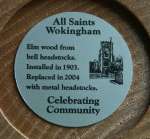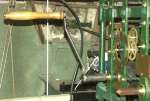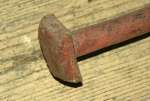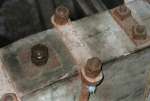Historic artefacts
Over the years, many things have changed. What has been replaced has mostly bee lost, but a few artefacts remain as a legacy of former years.
Bronze bearing block
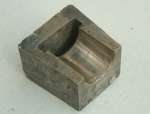 Prior to 1958, the bells were hung on plain bearings. The gudgeons on the ends of the headstocks rested in shaped blocks of bronze that allowed them to rotate. The bearings were lubricated with grease or tallow, and there was a cover over the top to keep dirt out. During a routine clean-up in 2009, one of these blocks was found hidden in a small gap under the end of the walkway in the bell chamber. It must be one of the blocks installed in 1903 and removed in 1958. The block is tapered to locate it within its mount, and it has a space to contain a reservoir of grease. [Currently out of the tower]
Prior to 1958, the bells were hung on plain bearings. The gudgeons on the ends of the headstocks rested in shaped blocks of bronze that allowed them to rotate. The bearings were lubricated with grease or tallow, and there was a cover over the top to keep dirt out. During a routine clean-up in 2009, one of these blocks was found hidden in a small gap under the end of the walkway in the bell chamber. It must be one of the blocks installed in 1903 and removed in 1958. The block is tapered to locate it within its mount, and it has a space to contain a reservoir of grease. [Currently out of the tower]
Clapper flight
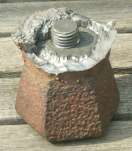 During a quarter peal in 1988, the flight of the Tenor clapper broke off. It didn't stop the bell striking, and the ringing continued. This was an unusual break – clappers usually break between the ball and shaft (see clapper in situ). The flight on the end of the clapper acts as a counterbalance to reduce the stress between ball and shank.
During a quarter peal in 1988, the flight of the Tenor clapper broke off. It didn't stop the bell striking, and the ringing continued. This was an unusual break – clappers usually break between the ball and shaft (see clapper in situ). The flight on the end of the clapper acts as a counterbalance to reduce the stress between ball and shank.
After the break, the clapper was mended by drilling holes in the ball and flight, tapping them to accept a threaded bar, screwing the two tightly together, and then running a deep weld round the edge of the break. The first repair failed the next year, and a deeper weld lasted five years. The third attempt lasted six years. The final break in 2002 was not mended, since the clappers were due to be replaced during the 2004 restoration anyway. [Currently out of the tower]
Wood from oak bell frame
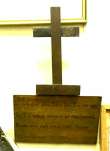 When the bells were augmented from six to eight in 1903, they were hung in a new iron frame. The old timber frame was removed, along with the decayed beams that supported it. Whether the timber from the old frame was burnt or re-used, we don’t know, but a piece of it survives. A small wooden cross hung for many years on the belfry wall, before being removed to make way for other things some time in the 1980s or 1990s. It is mounted over a wooden plaque inscribed: ‘Made for the belfry in 1928 by F Lush, a ringer of this parish, from old oak removed from the tower in 1903.’
When the bells were augmented from six to eight in 1903, they were hung in a new iron frame. The old timber frame was removed, along with the decayed beams that supported it. Whether the timber from the old frame was burnt or re-used, we don’t know, but a piece of it survives. A small wooden cross hung for many years on the belfry wall, before being removed to make way for other things some time in the 1980s or 1990s. It is mounted over a wooden plaque inscribed: ‘Made for the belfry in 1928 by F Lush, a ringer of this parish, from old oak removed from the tower in 1903.’
Frank Lush rang at All Saints from 1895 - 1946, and he appears in both the 1902 picture of All Saints ringers , and the 1923 picture of a peal band . Where the oak that he used to make the cross had been between 1903 and 1928 is a mystery.
When the cross was found in the clockroom during the clearout in 2004 the horizontal element was missing. It has been replaced with a piece cut from the Elm headstocks removed in 2004 and the cross was returned to the ringing room in 2021.
Wood from elm headstocks
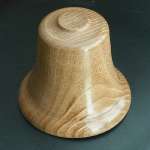 When the bell installation was modernism in 2004, the timber headstocks, installed in 1903, were replaced with cast iron headstocks. The old headstocks, of Elm, which was by this time a rare wood because of the effects of Dutch Elm Disease, were cut up and used to make wooden bells as mementos. Each bell carries a metal plaque on its base, recording the history of the wood. Nearly 100 were made and sold to parishioners, ringers and others interested in the bells. There is more detail here . [Wooden bells are all in private ownership. Some left over fragments of the timber still exist, also in private ownership.]
When the bell installation was modernism in 2004, the timber headstocks, installed in 1903, were replaced with cast iron headstocks. The old headstocks, of Elm, which was by this time a rare wood because of the effects of Dutch Elm Disease, were cut up and used to make wooden bells as mementos. Each bell carries a metal plaque on its base, recording the history of the wood. Nearly 100 were made and sold to parishioners, ringers and others interested in the bells. There is more detail here . [Wooden bells are all in private ownership. Some left over fragments of the timber still exist, also in private ownership.]
 Smaller pieces of wood from the old headstocks were used for other items, like a fid – a tool used to open up the gap between strands of rope, for example when splicing or tucking a tail end. [Two in private ownership]
Smaller pieces of wood from the old headstocks were used for other items, like a fid – a tool used to open up the gap between strands of rope, for example when splicing or tucking a tail end. [Two in private ownership]
Wooden pulleys
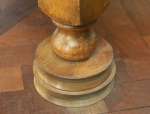 Wood is the traditional material for the ground pulleys that guide the rope beneath the bell. In the 2004 restoration, the pulleys were replaced with ones made of a lighter synthetic material. Eight of the old wooden pulleys were re-used to raise the height of a table (belonging to a tall ringer). The pulleys were fixed together in pairs , with a small recess turned in the top pulley to fit the metal dome on the bottom of the table leg. [In private ownership. Two unused.]
Wood is the traditional material for the ground pulleys that guide the rope beneath the bell. In the 2004 restoration, the pulleys were replaced with ones made of a lighter synthetic material. Eight of the old wooden pulleys were re-used to raise the height of a table (belonging to a tall ringer). The pulleys were fixed together in pairs , with a small recess turned in the top pulley to fit the metal dome on the bottom of the table leg. [In private ownership. Two unused.]
Clock winder
 For 188 years, the clock was wound by hand, using a large cranked handle that slots onto either of the two winding shafts, one for the weight that drives the clock, and one for the weight that drive the striking. During the 1980s, the handle broke and was repaired by welding. At the same time, the handle was given an offset, to make it easier to wind the clock without bumping one's shoulders on the clock case. When the auto-wind mechanism was fitted in 2005, the winding handle became redundant, and hasn't been used since. [In the clock room]
For 188 years, the clock was wound by hand, using a large cranked handle that slots onto either of the two winding shafts, one for the weight that drives the clock, and one for the weight that drive the striking. During the 1980s, the handle broke and was repaired by welding. At the same time, the handle was given an offset, to make it easier to wind the clock without bumping one's shoulders on the clock case. When the auto-wind mechanism was fitted in 2005, the winding handle became redundant, and hasn't been used since. [In the clock room]
Eye bolt
 This rather insignificant item played a key role in the clock up until 1994. The wire cable carrying the weight that drives the clock used to run from the clock, down about ten feet to the clockroom floor and then back up to the ceiling over a pulley and down the weight shaft. The pulley block at the bottom of this pointless diversion was attached to this eye bolt, which was screwed into the floor. See the full explanation . [Currently in private hands.]
This rather insignificant item played a key role in the clock up until 1994. The wire cable carrying the weight that drives the clock used to run from the clock, down about ten feet to the clockroom floor and then back up to the ceiling over a pulley and down the weight shaft. The pulley block at the bottom of this pointless diversion was attached to this eye bolt, which was screwed into the floor. See the full explanation . [Currently in private hands.]
Iron bolt
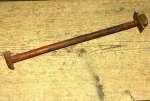 When the bells were hung on timber headstocks, long bolts , the full depth of the headstock, were used to attach the bell and fittings to each headstock. Typically there were 12 for each bell (4 holding the bell and 4 each for the two gudgeon plates). The heads of the bolts are slightly irregular, and may have been made by a blacksmith. (Webb & Bennett, who hung the bells in 1903 were blacksmiths before they took up bell hanging.) One of the bolts survives. [In the clockroom]
When the bells were hung on timber headstocks, long bolts , the full depth of the headstock, were used to attach the bell and fittings to each headstock. Typically there were 12 for each bell (4 holding the bell and 4 each for the two gudgeon plates). The heads of the bolts are slightly irregular, and may have been made by a blacksmith. (Webb & Bennett, who hung the bells in 1903 were blacksmiths before they took up bell hanging.) One of the bolts survives. [In the clockroom]
Iron strap
 Most of the bells were arranged with two bolts each side of the timber headstock, with two iron straps across the top of the headstock to spread the load of the bolts across the timber. Several of these iron straps survive. [In the clockroom]
Most of the bells were arranged with two bolts each side of the timber headstock, with two iron straps across the top of the headstock to spread the load of the bolts across the timber. Several of these iron straps survive. [In the clockroom]
Wheel weight
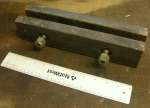 Before 2004 some of the bells were `odd struck', ie when the bell swung evenly the timing between successive strokes was different. It was caused by misalignment between the bell pivot, the clapper pivot and the bell's centre of gravity. The way the bells were hung didn't make it possible to correct that but the effect was offset by clamping weights on one side of the wheel to move the effective centre of gravity slightly. These are no longer needed since the 2004 installation included adjusters to bring the clapper into alignment. [In private ownership.]
Before 2004 some of the bells were `odd struck', ie when the bell swung evenly the timing between successive strokes was different. It was caused by misalignment between the bell pivot, the clapper pivot and the bell's centre of gravity. The way the bells were hung didn't make it possible to correct that but the effect was offset by clamping weights on one side of the wheel to move the effective centre of gravity slightly. These are no longer needed since the 2004 installation included adjusters to bring the clapper into alignment. [In private ownership.]
Pictures
 Prior to 1958, the bells were hung on plain bearings. The gudgeons on the ends of the headstocks rested in shaped blocks of bronze that allowed them to rotate. The bearings were lubricated with grease or tallow, and there was a cover over the top to keep dirt out. During a routine clean-up in 2009, one of these blocks was found hidden in a small gap under the end of the walkway in the bell chamber. It must be one of the blocks installed in 1903 and removed in 1958. The block is tapered to locate it within its mount, and it has a space to contain a reservoir of grease. [Currently out of the tower]
Prior to 1958, the bells were hung on plain bearings. The gudgeons on the ends of the headstocks rested in shaped blocks of bronze that allowed them to rotate. The bearings were lubricated with grease or tallow, and there was a cover over the top to keep dirt out. During a routine clean-up in 2009, one of these blocks was found hidden in a small gap under the end of the walkway in the bell chamber. It must be one of the blocks installed in 1903 and removed in 1958. The block is tapered to locate it within its mount, and it has a space to contain a reservoir of grease. [Currently out of the tower] 


 Smaller pieces of wood from the old headstocks were used for other items, like a fid – a tool used to open up the gap between strands of rope, for example when splicing or tucking a tail end. [Two in private ownership]
Smaller pieces of wood from the old headstocks were used for other items, like a fid – a tool used to open up the gap between strands of rope, for example when splicing or tucking a tail end. [Two in private ownership]




 Before 2004 some of the bells were `odd struck', ie when the bell swung evenly the timing between successive strokes was different. It was caused by misalignment between the bell pivot, the clapper pivot and the bell's centre of gravity. The way the bells were hung didn't make it possible to correct that but the effect was offset by clamping weights on one side of the wheel to move the effective centre of gravity slightly. These are no longer needed since the 2004 installation included adjusters to bring the clapper into alignment. [In private ownership.]
Before 2004 some of the bells were `odd struck', ie when the bell swung evenly the timing between successive strokes was different. It was caused by misalignment between the bell pivot, the clapper pivot and the bell's centre of gravity. The way the bells were hung didn't make it possible to correct that but the effect was offset by clamping weights on one side of the wheel to move the effective centre of gravity slightly. These are no longer needed since the 2004 installation included adjusters to bring the clapper into alignment. [In private ownership.] 

